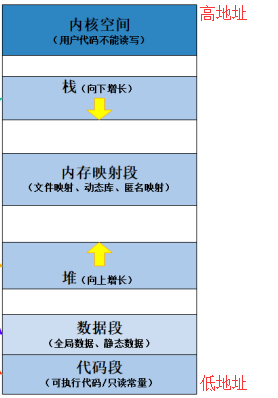一、C/C++内存分布
先看一段C语言代码:
int globalVar = 1;
static int staticGlobalVar = 1;
void Test() {
static int staticVar = 1;
int localVar = 1;
int num1[10] = { 1, 2, 3, 4 };
char char2[] = "abcd";
char* pChar3 = "abcd";
int* ptr1 = (int*)malloc(sizeof(int) * 4);
int* ptr2 = (int*)calloc(4, sizeof(int));
int* ptr3 = (int*)realloc(ptr2, sizeof(int) * 4);
free(ptr1);
free(ptr3);
}1、所在内存区域
| globalVar->数据段(静态区) |
staticGlobalVar->数据段(静态区) |
| staticVar->数据段(静态区) | localVar->栈 |
| num1->栈 | |
| char2->栈(栈帧) | *char2->栈(栈帧) |
| pChar3->栈(栈帧) | *pChar3->代码段 |
| ptr1->栈(栈帧) | *ptr1->堆 |
2、sizeof 和 strlen
| sizeof(num1) = 40 | sizeof(char2) = 5 |
| sizeof(pChar3) = 4 / 8 | sizeof(ptr1) = 4 / 8 |
| strlen(char2) = 4 | strlen(pChar3) = 4 |
3、C/C++中程序内存区域划分

栈:又叫堆栈,非静态局部变量/函数参数/返回值等等,栈是向下增长的;
内存映射段:是高效I/O映射方式,用于装载一个共享的动态内存库。用户可使用系统接口创建共享内存,做进程间通信;
堆:用于程序运行时动态内存的分配,堆是向上增长的;
数据段:存储全局数据和静态数据;
代码段:可执行的代码 / 只读常量;
二、C语言中动态内存管理方式
1、malloc / calloc / realloc 和 free
void Test() {
int* ptr1 = (int*)malloc(sizeof(int));
free(ptr1);
int* ptr2 = (int*)calloc(4, sizeof(int));
int* ptr3 = (int*)realloc(ptr2, sizeof(int) * 10);
free(ptr3);
}
注意:ptr2不需要释放,因为 realloc 只是对 ptr2的原有基础上进行了扩容,实际上用的是同一块内存空间;
2、malloc / calloc / realloc 的区别
共同点:都是程序猿从堆上申请空间的方法,并且需要手动释放或者在程序结束运行的时候自动释放,否则会造成内存泄露;
malloc:分配的内存是位于堆中的,并且没有初始化内存的内容,因此基本上malloc之后,调用函数memset来初始化这部分的内存空间;
calloc:将初始化这部分的内存;
realloc:则对malloc 、 realloc 申请的内存进行大小的调整;
3、alloca
alloca是从栈上申请内存空间,且不需要释放,由系统自动释放;
三、C++内存管理方式
1、new / delete 操作内置类型
void Test() {
int* ptr1 = new int;
int* ptr2 = new int(10);
int* ptr3 = new int[3];
delete ptr1;
delete ptr2;
delete[] ptr3;
}ptr1 ==> 动态申请了一个int类型的空间;
ptr2 ==> 动态申请了一个int类型的空间并初始化为10;
ptr3 ==> 动态申请了一个int型数组,数组大小是在[ ]中指定
注意:申请和释放单个元素的空间,使用 new 和 delete 操作符;申请和释放连续空间,使用 new[ ] 和 delete[ ];
2、new / delete 操作自定义类型
class TestT {
public:
TestT()
:_data(0)
{
cout << "TestT()" << endl;
}
~TestT() {
cout << "~TestT()" << endl;
}
private:
int _data;
};
以 malloc 来动态申请内存:
void Test() {
TestT* t1 = (TestT*)malloc(sizeof(TestT));
free(t1);
TestT* t2 = (TestT*)malloc(sizeof(TestT) * 10);
free(t2);
}
以 new 来动态申请内存:
void Test() {
TestT* t1 = new TestT;
delete t1;
TestT* t2 = new TestT[10];
delete t2;
}
结论:在申请自定义类型的空间时,new 会调用构造函数,delete 会调用析构函数,而 malloc 和 free 不会;
四、operator new和operator delete函数
new 和 delete 是用户进行动态内存申请和释放的操作符,operator new 和 operator delete 是系统提供的全局函数;
new 在底层是调用operator new 全局函数来申请空间,delete 是在底层调用 operator delete 全局函数来释放空间;
void* __CRTDECL operator new(size_t size) _THROW(_STD bad_alloc){
void* p;
while((p = malloc(size) == 0)
if (_callnewh(size) == 0) {
static const std::bad_alloc nomem;
_RAISE(nomem);
}
return (p);
}
void operator delete(void* pUserData)
{
_CrtMemBlockHeader* pHead;
RTCCALLBACK(_RTC_Free_hook, (pUserData, 0));
if (pUserData == NULL)
return;
/* get a pointer to memory block header */
pHead = pHdr(pUserData);
/* verify block type */
_ASSERTE(_BLOCK_TYPE_IS_VALID(pHead->nBlockUse));
_free_dbg(pUserData, pHead->nBlockUse);
__FINALLY
_munlock(_HEAP_LOCK); /* release other threads */
__END_TRY_FINALLY
return;
}
/*
free的实现
*/
#define free(p) _free_dbg(p, _NORMAL_BLOCK)由上面的代码可以看出来:
operator new 实际也是通过malloc来申请空间,如果malloc申请空间成功就直接返回,否则执行用户提供的空间不足应对措施,如果用户提供该措施就继续申请,否则就抛异常;
operator delete 最终是通过 free 来释放空间的;
五、new和delete的实现原理
1、内置类型
如果申请的是内置类型的元素,new 和 malloc,delete 和 free 基本类似;
不同的地方是:new / delete 申请和释放的是单个元素的空间,new[ ] / delete[ ] 申请的是连续的空间,而 new 在申请失败的时候会抛异常,malloc 会返回 NULL;
2、自定义类型
1、调用operator new 函数申请空间;
2、在申请的空间上执行构造函数,完成对象的构造;
1、在空间上执行析构函数,完成对象中资源的清理工作;
2、调用 operator delete 函数释放对象的空间;
1、调用operator new[ ]函数,在operator new[ ]中实际调用 operator new 函数完成N个对象空间的申请;
2、在申请的空间上执行N次构造函数;
1、在释放的对象空间上执行N次析构函数,完成N个对象的资源清理;
2、调用 operator delete[ ] 释放空间,实际在operator delete[ ]中调用 operator delete 来释放空间;
- new的原理
- delete的原理
- new T[N]的原理
- delete[ ]的原理
六、定位new表达式(placement-new)
定位 new 表达式在已经分配的原始内存空间中调用构造函数初始化一个对象;
使用格式:
new(place-address) type 或者 new (place-address) type(initializer-list)
place-address 必须是一个指针,initializer-list 是类型的初始化列表
使用场景:
定位 new 表达式在实际中一般是配合内存池使用。因为内存池分配出的内存没有初始化,所以如果是自定义类型的对象,需要使用 new 的定义表达式进行显示调构造函数并进行初始化;
class TestT {
public:
TestT()
:_data(0)
{
cout << "TestT()" << endl;
}
~TestT()
{
cout << "~TestT()" << endl;
}
private:
int _data;
};
void Test() {
TestT* pt = (TestT*)malloc(sizeof(TestT));
new(pt) TestT;
}
七、malloc / free 和 new / delete 的区别
1、相同点:
- 都是从堆上申请空间,并且需要用户手动释放;
2、不同点:
- malloc 和 free 是函数, new 和 delete 是操作符;
- malloc 申请的空间不会初始化,new 可以进行初始化;
- malloc 申请空间时,需要手动计算空间的大小并传递, new 只需要跟上空间的类型即可;
- malloc 的返回值为 void* ,在使用时必须进行强制转化,new 不需要;
- malloc 申请空间失败时,返回的是 NULL,因此使用期间必须进行判空,new 不需要,但是 new 需要捕获异常;
- 申请自定义类型对象时,malloc / free 只会开辟空间,而 new / delete 在申请和释放空间的时候,会调用构造 / 析构 函数;
- new / delete 比 malloc / free 的效率稍微低一些,因为 new / delete 的底层封装了 malloc / free;
